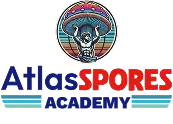Quick Learn Summary
Time needed: 15-20 minutes for basic preparation
Skill level: Beginner-friendly with proper guidance
Key success factors: Clean workspace, proper hydration, gentle mounting technique
Essential supplies: Microscope slides, cover slips, spore syringe, distilled water, sterile technique materials
Learning outcome: Master the fundamental skill of creating clear, professional-quality spore slides for detailed microscopic examination and research documentation.
Understanding the Importance of Proper Slide Preparation
Quality slide preparation serves as the gateway between raw spore samples and meaningful scientific observation. When done correctly, a well-prepared slide allows you to observe critical spore characteristics including shape, size, surface texture, and internal structures. These details are crucial for species identification, research documentation, and understanding the reproductive biology of different fungal varieties.
Did you know? Professional mycologists can identify many mushroom species solely from spore characteristics observed under microscopy. The preparation technique you learn today forms the foundation for advanced taxonomic work and scientific research.
The goal of slide preparation is to create a thin, uniform layer of properly hydrated spores that can be observed clearly under various magnification levels. This requires balancing several factors: adequate hydration for optimal spore visibility, appropriate sample density for clear observation, and maintaining a sterile environment to prevent contamination that could obscure your results.
Essential Equipment and Materials
Primary Supplies Needed
- Microscope slides: High-quality glass slides, preferably pre-cleaned and sterilized
- Cover slips: Thin glass covers (typically 18mm x 18mm or 22mm x 22mm)
- Spore syringe: Clean, research-grade spore suspension
- Distilled water: For dilution and mounting medium
- Transfer pipettes: For precise liquid handling
- Paper towels: Lint-free, absorbent material for cleanup
- Alcohol wipes: 70% isopropyl alcohol for surface sterilization
Workspace Setup Requirements
- Clean, well-lit work surface
- Adequate ventilation to prevent condensation
- Organized storage for slides and materials
- Easy access to disposal containers for waste materials
Step-by-Step Preparation Process
Workspace Preparation and Sterilization
Begin by thoroughly cleaning your work surface with alcohol wipes, paying special attention to areas where slides and materials will be placed. Arrange your supplies in an organized manner, keeping spore syringes, slides, and cover slips within easy reach. Wash your hands thoroughly and consider wearing nitrile gloves to maintain cleanliness throughout the process.
Ensure your microscope slides are clean and free from dust or residue. If using pre-cleaned slides, a gentle wipe with a lint-free cloth is usually sufficient. For added sterility, you can briefly flame sterilize metal tools or wipe them with alcohol.
Spore Sample Preparation
Gently agitate your spore syringe to ensure even distribution of spores throughout the suspension. The goal is to create a uniform mixture without introducing air bubbles that could interfere with observation. If your spore concentration appears too dense, prepare a dilution using distilled water in a ratio of 1:1 or 1:2, depending on the original density.
Place a clean microscope slide on your work surface. Using steady hands, dispense 1-2 drops of spore suspension onto the center of the slide. The amount should be sufficient to cover the area under a standard cover slip without overflowing when the cover slip is applied.
Cover Slip Application and Final Mounting
Hold the cover slip at a 45-degree angle to the slide surface, touching one edge of the spore drop first. Slowly lower the cover slip, allowing the liquid to spread evenly underneath while minimizing air bubble formation. The goal is to create a thin, uniform layer of spores between the slide and cover slip.
Gently press down on the cover slip to eliminate any obvious air bubbles, but avoid excessive pressure that could damage spores or create uneven distribution. Allow the slide to settle for 2-3 minutes before observation, giving the spores time to settle into a single plane of focus.
Common Preparation Mistakes and Solutions
Problem: Excessive Air Bubbles
Air bubbles interfere with clear observation and can obscure important spore details.
Problem: Spore Concentration Too Dense
Overcrowded spores prevent clear individual observation and make detailed study impossible.
Problem: Uneven Spore Distribution
Spores clumped in certain areas while other regions remain sparse.
Troubleshooting Advanced Preparation Challenges
Optimizing Spore Visibility
Challenge: Spores appear too transparent or difficult to distinguish
Solutions: Adjust microscope lighting and contrast settings, consider phase contrast microscopy for better definition, or use staining techniques for enhanced visibility. Some researchers add a small amount of methylene blue to improve contrast.
Managing Sample Longevity
Challenge: Slides dry out quickly during extended observation
Solutions: Work in higher humidity environments when possible, use sealed slide chambers for long-term study, or prepare multiple slides for extended research sessions.
Achieving Consistent Results
Challenge: Slide quality varies between preparations
Solutions: Standardize your technique by measuring drop volumes, maintaining consistent cover slip application angles, and establishing standard dilution ratios for different spore concentrations.
Advancing Your Microscopy Skills
Now that you’ve mastered basic slide preparation, you’re ready to explore more advanced microscopy techniques. Consider learning about different staining methods that can highlight specific spore structures, or investigate phase contrast and dark-field microscopy for enhanced observation capabilities.
Build a comprehensive spore slide library by preparing samples from different species and documenting your observations with detailed notes and photography. This systematic approach transforms individual slide preparations into a valuable research collection.
For researchers interested in advancing their laboratory capabilities, explore professional-grade equipment options and consider connecting with local mycological societies or educational institutions that offer advanced microscopy workshops.
Frequently Asked Questions
Educational Disclaimer: This content is provided for educational and research purposes only. Spore microscopy should be conducted in compliance with local laws and regulations. This guide is not intended for cultivation or consumption purposes.
